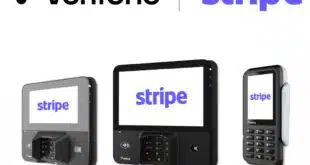Shopify Inc.’s recent move to offer its merchants a mobile point-of-sale application marks yet another entry in a market that has filled up fast with competitors ranging from PayPal Inc. to Square Inc. and dozens in between. “You would think we’d reached everybody [with mobile POS products], but we haven’t,” says James Wester, a senior analyst who follows mobile payments at IDC Financial Insights, Framingham, Mass.
But Ottawa-based Shopify could have a built-in advantage: a fast-growing base of merchant clients looking for mobile acceptance capability consolidated with existing online services.
Eight-year-old Shopify, which provides an e-commerce platform for about 80,000 merchants, introduced the mobile POS service last week as part of a new app for Apple Inc.’s iPhone. It’s early, but so far about 1,800 merchants have ordered it, the company says. An Android version is expected.
The product includes a free card reader made for Shopify by Boston-based Roam Data Inc., which manufactures its distinctive half-moon-shaped dongles for a number of mobile-acceptance providers, including Groupon. Transactions flow through Shopify Payments, a platform the company introduced in August to process payments and link transaction data to clients’ inventory-management and other functions. Online payment processor Stripe provides settlement.
Though Shopify serves online sellers, it found a wide range of these merchants wanted a face-to-face processing capability, both for routine business and for occasional use at trade fairs and the like, Carson Brown, product manager for Shopify Mobile, tells Digital Transactions News. “We knew we wanted to get into that space,” he says.
There was a sense of urgency behind the new service. The company found through polling its clients that a “large portion” had already turned to competitive mobile products, he says. “We thought we could provide a better experience,” he adds.
That’s because the mobile service ties into the same database as the online service, allowing merchants to run reports and track information on the same platform. That simplifies bookkeeping, inventory control, and marketing and avoids having to reconcile a Shopify online account with transactions run on an outside system, Brown says. “We’re taking away a lot of that complexity,” he adds.
Indeed, while dozens of providers have crowded into the mobile POS market since 2009, when Square and Intuit Inc. launched their services, Shopify may have an edge with its rapidly growing base of online merchants. The company’s client count is doubling annually, says Louis Kearns, director of payments, implying it will have about 160,000 merchants signed up by year’s end.
At the same time, if many of those clients were turning to other services, Shopify had little choice but to offer its own, says Wester. These days, with the availability of application programming interfaces and code libraries, “it’s relatively easy for an online retailer to switch over to another gateway if you’re not providing everything they need,” he says. “It’s not as difficult as it used to be. You don’t need that in-house coding capability.”
Shopify offers more or less competitive pricing. There are three tiers, depending on the overall e-commerce service level the merchant signs up for. The top tier, which costs $179 a month, offers the POS service for 2.1% plus 30 cents per transaction. The middle tier, at $79 per month, levies a fee of 2.3% plus 30 cents, while the last tier carries a price of 2.5% plus 30 cents for a $29 monthly fee. Square, for example, charges a flat 2.75% per transaction.
The new iOS application adds to Shopify’s thrust into the business of processing card-present transactions that began last August with the introduction of Shopify POS, a service that lets merchants that have physical stores run their registers on Apple’s iPad tablet.
This, too, is a crowded market, and becoming increasingly so, but Shopify may have another key advantage. In December, it raised $100 million in a Series C funding round, with the money earmarked specifically for its move into physical-world services. “We’re really focused now on being the facility where merchants sell their products anywhere they want to sell them,” says Kearns.
As for those mobile rivals, Kearns isn’t fazed. “We can go head-to-head with existing players in the space,” he says.





